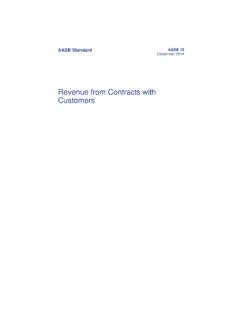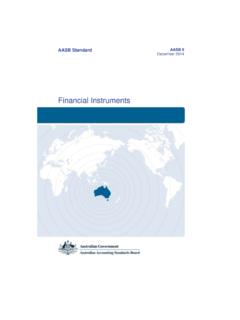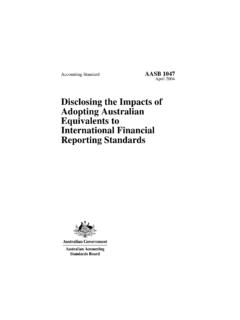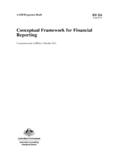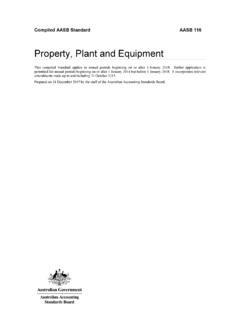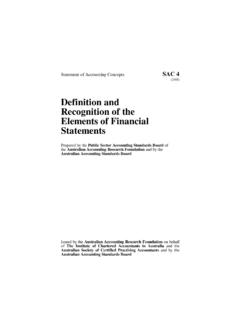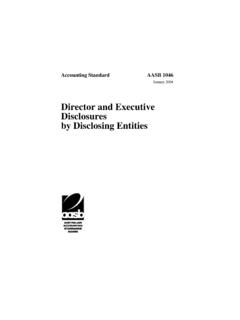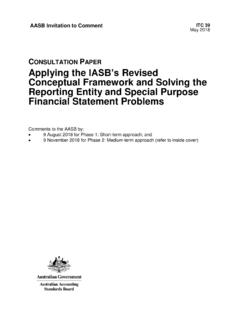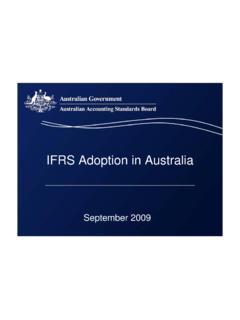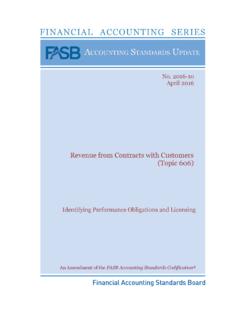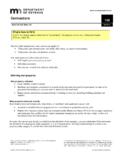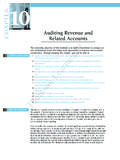Transcription of Revenue from Contracts with Customers
1 Compiled AASB Standard AASB 15. Revenue from Contracts with Customers This compiled Standard applies to annual periods beginning on or after 1 January 2018. Earlier application is permitted. It incorporates relevant amendments made up to and including 22 October 2015. Prepared on 7 December 2015 by the staff of the Australian Accounting Standards Board. Obtaining copies of Accounting Standards Compiled versions of Standards, original Standards and amending Standards (see Compilation Details) are available on the AASB website: Australian Accounting Standards Board PO Box 204. Collins Street West Victoria 8007. AUSTRALIA. Phone: (03) 9617 7637. E-mail: Website: Other enquiries Phone: (03) 9617 7600. E-mail: COPYRIGHT. Commonwealth of Australia 2015. This compiled AASB Standard contains IFRS Foundation copyright material. Reproduction within Australia in unaltered form (retaining this notice) is permitted for personal and non-commercial use subject to the inclusion of an acknowledgment of the source.
2 Requests and enquiries concerning reproduction and rights for commercial purposes within Australia should be addressed to The Director of Finance and Administration, Australian Accounting Standards Board, PO Box 204, Collins Street West, Victoria 8007. All existing rights in this material are reserved outside Australia. Reproduction outside Australia in unaltered form (retaining this notice) is permitted for personal and non-commercial use only. Further information and requests for authorisation to reproduce for commercial purposes outside Australia should be addressed to the IFRS Foundation at AASB 15-compiled 2 COPYRIGHT. Contents COMPARISON with IFRS 15. ACCOUNTING STANDARD. AASB 15 Revenue FROM Contracts with Customers . from paragraph OBJECTIVE 1. Meeting the objective 2. SCOPE 5. RECOGNITION. Identifying the contract 9. Combination of Contracts 17. contract modifications 18.
3 Identifying performance obligations 22. Promises in Contracts with Customers 24. Distinct goods or services 26. Satisfaction of performance obligations 31. Performance obligations satisfied over time 35. Performance obligations satisfied at a point in time 38. Measuring progress towards complete satisfaction of a performance obligation 39. MEASUREMENT 46. Determining the transaction price 47. Variable consideration 50. The existence of a significant financing component in the contract 60. Non-cash consideration 66. Consideration payable to a customer 70. Allocating the transaction price to performance obligations 73. Allocation based on stand-alone selling prices 76. Allocation of a discount 81. Allocation of variable consideration 84. Changes in the transaction price 87. contract COSTS. Incremental costs of obtaining a contract 91. Costs to fulfil a contract 95. Amortisation and impairment 99.
4 PRESENTATION 105. DISCLOSURE 110. Contracts with Customers 113. Disaggregation of Revenue 114. contract balances 116. Performance obligations 119. Transaction price allocated to the remaining performance obligations 120. Significant judgements in the application of this Standard 123. Determining the timing of satisfaction of performance obligations 124. Determining the transaction price and the amounts allocated to performance obligations 126. Assets recognised from the costs to obtain or fulfil a contract with a customer 127. Practical expedients 129. AASB 15-compiled 3 CONTENTS. COMMENCEMENT OF THE LEGISLATIVE INSTRUMENT APPENDICES. A Defined terms B Application guidance C Effective date and transition E Australian reduced disclosure requirements COMPILATION DETAILS. DELETED IFRS 15 TEXT. AVAILABLE ON THE AASB WEBSITE. Introduction to IFRS 15. Illustrative examples Basis for Conclusions on IFRS 15.
5 Australian Accounting Standard AASB 15 Revenue from Contracts with Customers (as amended) is set out in paragraphs 1 and Appendices A C and E. All the paragraphs have equal authority. Paragraphs in bold type state the main principles. Terms defined in Appendix A are in italics the first time they appear in the Standard. AASB 15 is to be read in the context of other Australian Accounting Standards, including AASB 1048 Interpretation of Standards, which identifies the Australian Accounting Interpretations, and AASB 1057 Application of Australian Accounting Standards. In the absence of explicit guidance, AASB 108 Accounting Policies, Changes in Accounting Estimates and Errors provides a basis for selecting and applying accounting policies. AASB 15-compiled 4 CONTENTS. Comparison with IFRS 15. AASB 15 Revenue from Contracts with Customers as amended incorporates IFRS 15 Revenue from Contracts with Customers as issued and amended by the International Accounting Standards Board (IASB).
6 Australian-specific paragraphs (which are not included in IFRS 15) are identified with the prefix Aus . Paragraphs that apply only to not-for-profit entities begin by identifying their limited applicability. Tier 1. For-profit entities complying with AASB 15 also comply with IFRS 15. Not-for-profit entities' compliance with IFRS 15 will depend on whether any Aus paragraphs that specifically apply to not-for-profit entities provide additional guidance or contain applicable requirements that are inconsistent with IFRS 15. Tier 2. Entities preparing general purpose financial statements under Australian Accounting Standards Reduced Disclosure Requirements (Tier 2) will not be in compliance with IFRSs. AASB 1053 Application of Tiers of Australian Accounting Standards explains the two tiers of reporting requirements. AASB 15-compiled 5 COMPARISON. Accounting Standard AASB 15.
7 The Australian Accounting Standards Board made Accounting Standard AASB 15 Revenue from Contracts with Customers under section 334 of the Corporations Act 2001 on 12 December 2014. This compiled version of AASB 15 applies to annual periods beginning on or after 1 January 2018. It incorporates relevant amendments contained in other AASB Standards made by the AASB up to and including 22 October 2015. (see Compilation Details). Accounting Standard AASB 15. Revenue from Contracts with Customers Objective 1 The objective of this Standard is to establish the principles that an entity shall apply to report useful information to users of financial statements about the nature, amount, timing and uncertainty of Revenue and cash flows arising from a contract with a customer . Meeting the objective 2 To meet the objective in paragraph 1, the core principle of this Standard is that an entity shall recognise Revenue to depict the transfer of promised goods or services to Customers in an amount that reflects the consideration to which the entity expects to be entitled in exchange for those goods or services.
8 3 An entity shall consider the terms of the contract and all relevant facts and circumstances when applying this Standard. An entity shall apply this Standard, including the use of any practical expedients, consistently to Contracts with similar characteristics and in similar circumstances. 4 This Standard specifies the accounting for an individual contract with a customer . However, as a practical expedient, an entity may apply this Standard to a portfolio of Contracts (or performance obligations) with similar characteristics if the entity reasonably expects that the effects on the financial statements of applying this Standard to the portfolio would not differ materially from applying this Standard to the individual Contracts (or performance obligations) within that portfolio. When accounting for a portfolio, an entity shall use estimates and assumptions that reflect the size and composition of the portfolio.
9 Scope 5 An entity shall apply this Standard to all Contracts with Customers , except the following: (a) lease Contracts within the scope of AASB 117 Leases;. (b) insurance Contracts within the scope of AASB 4 Insurance Contracts ;. (c) financial instruments and other contractual rights or obligations within the scope of AASB 9. Financial Instruments, AASB 10 Consolidated Financial Statements, AASB 11 Joint Arrangements, AASB 127 Separate Financial Statements and AASB 128 Investments in Associates and Joint Ventures; and (d) non-monetary exchanges between entities in the same line of business to facilitate sales to Customers or potential Customers . For example, this Standard would not apply to a contract between two oil companies that agree to an exchange of oil to fulfil demand from their Customers in different specified locations on a timely basis. 6 An entity shall apply this Standard to a contract (other than a contract listed in paragraph 5) only if the counterparty to the contract is a customer .
10 A customer is a party that has contracted with an entity to obtain goods or services that are an output of the entity's ordinary activities in exchange for consideration. A. counterparty to the contract would not be a customer if, for example, the counterparty has contracted with the entity to participate in an activity or process in which the parties to the contract share in the risks and benefits that result from the activity or process (such as developing an asset in a collaboration arrangement). rather than to obtain the output of the entity's ordinary activities. AASB 15-compiled 6 STANDARD. 7 A contract with a customer may be partially within the scope of this Standard and partially within the scope of other Standards listed in paragraph 5. (a) If the other Standards specify how to separate and/or initially measure one or more parts of the contract , then an entity shall first apply the separation and/or measurement requirements in those Standards.
